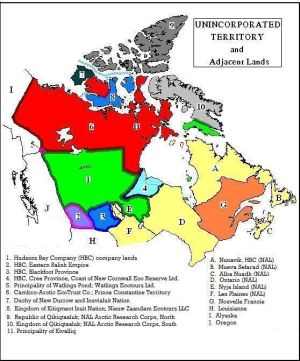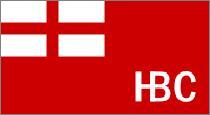Unincorporated Territories

| |
| Motto: PROUDLY UNINCORPORATED! | |
| Subdivision of: | NAL |
| Cities: | |
| Capital: | Winnipeg |
| Other: | Edmonton, Calgary, Regina, Kimmirut |
| Languages: | |
| Official: | English, Michif |
| Others: | Many |
| Commissioner: | Lord Aldon Grey |
| President of the Council: | Lilly Anawak |
| Established: | 1871, Treaty of Friendship and Harmony |
The Unincorporated Territories is a semi-autonomous, largely Native, area of the North American League, which has remained outside of the Council Fire. It is the last remaining and by far largest extraprovincial territory of the NAL, having outlived the Transylvania Territory as well as the Southwest and Northwest Territories.
Administration
Government
The Unincorporated Territories is a loose federation of various territories: Native nations, Company lands, and private fiefdoms. One European settled territory, New Iceland, has since become a Province of the NAL. The UT is ultimately governed by the Extraterritorial Lands Bureau in Philadelphia (which also have oversight over the Dry Tortugas in the Caribbean and a couple other out-of-the-way locales), and is overseen by the Commissioner of the Unincorporated Territories as the supreme executive authority. (He is affectionately referred to as "Our Lord Governor" by the natives.) The Bureau works alongside the Council of Nations and Companies at Winnipeg and generally concedes to the Parliament on internal matters. The Bureau intervenes only in matters of national concern or to arbitrate disputes. The Bureau also has sole control over external matters, including relations with other Provinces (subject to the Treaty Rights).
The UT's governing body is comprised of a mixed executive-legislative body known as the Council of Nations and Companies which is headed by a Chairman. MPs are elected or appointed per local custom by the Nations, each nation sending three MPs (except for Watlings Pond which sends three and a half MPs, the half being a husky). The Council is bicameral, though the eldest MP from each Nation comprise a special Council of Elders that may be called upon to consider matters of utmost importance where their great wisdom should prevail over emotion or popular whim. The Chairmanship is rotated among the Nations and naturally is a matter of no little pride when a Nation hosts the Chairman's office. A Parliament sits for a term of five years. MPs are not restricted to term limits, but few last more than two or three terms as the harsh climate seems to provide ample reason for people to expect much from their political leaders and are not willing to hang on to worthless MPs.
The Parliament is a big deal among Territorians, as it provides a place where local issues and concerns can receive Territory wide attention. The opening and closing of sessions are also a big deal, as they are accompanied by much pomp and ceremony. Part pauwau and part potlatch, there is a general atmosphere of festivity and ceremony each year as all the MPs dress in full regalia and their nations' ceremonial dancers and singers perform for the festival's crowds. Many tourists come up from the Underlands (the rest of the NAL's provinces) to attend the fortnight long festival, the end of which is marked by the Chairman declaring Parliament officially open.
A UT local summed it up this way ... "Public life is interesting up here: there is little or no guidance from Our Lord Governor in Philadelphia, so we have made our own government over the years. We have our own Parliament that meets at Winnipeg down in Blackfoot Province. It's made up of MPs from all the Company lands, the Native lands and the quirky private lands. Technically, we're probably not supposed to do this, but Philadelphia doesn't seem to mind much about us if we don't mess with the RAF or Continental Army bases. We're happy being Americans and all that, but we're also happy being a little different from the rest of America."
Federal Law is not understood to be superior to Territorian Law, except in so far as matters of utmost importance to national security are concerned. For a federal law to take effect in the UT, it must be ratified by the Council. Most such laws are first modified by Territorian lawmakers to better suit their constituencies and the environment of the UT itself.
Treaty Rights
The UT's government enjoys special rights granted by the original Treaty of Friendship and Harmony, and amended by further treaties and court rulings. The most important of these are the right to restrict immigration.
Members
The UT is composed of a number of territories, known as Nations. Several of these Nations are not geographically contiguous, but rather, consist of a number of enclaves made up of towns and cities and some surrounding countryside. Most of the Nations comprise larger territories, administered by one of two great and ancient Companies (the Hudson Bay and the Cambro-Arctic). Three of the Nations comprise provinces within the HBC's lands. See the map here in the Maps Page. Each Nation has its own body of laws, drawn mostly from Native traditions and mixed with archaic British law and jurisprudence, and most have some sort of local parliament or elective council that decides on local issues. In addition, these local bodies are responsible for organising elections to the Council of Nations and Companies.
Nations (Provinces) of the UT and their subdivisions (likely incomplete) are:
- Hudson Bay Company Territory
- Cambro-Arctic EcoTrust Co.
- Athapaskan
- Western Inuit Union
- Fief of New Cambria (Trans Arctic Tourism Co.)
- Prince Constantine Territory
- Principality of Kivalliq
- Principality of Watlings Pond (Watling Street Ecotours Ltd.)
- Caska Dena Council
- Duchy of New Durrow
- Kingdom of Kitikmeot Inuit Nation
- Ysl Dewi Saeth
- Republic of Qikiqtaaluk; NAL Arctic Research Corps, Northern Territory
- Kingdom of Qikiqtaaluk; NAL Arctic Research Corps, Southern Territory
These I need to figure where their territories are:
- Dene
- Dunneza
- Métis Union
- Kainai Nation
- Pikuni Nation
- Siksika Nation
- Tsuu T'ina
- Siglitun
- Inuinnaqtun
- Natsilingmiutut
- Kivallirmiutut
- Aivilimmiutut
- Qikiqtaaluk uannangani
- Qikiqtaaluk nigiani
History
The origin of the Unincorporated Territories is the 1871 Treaty of Friendship and Harmony between the government of the North American League and a federation of native nations, following the Red River Rebellion. The Métis and Natives were granted the North-Western Territory and Rupert's Land west of the Nelson River. The remainder of Rupert's Land became the Territory of Rupert's Land, later annexed by the province of Ontario.
Much of this territory consisted of the Hudson Bay Company and Cambro-Arctic Exploration Company (now Cambro-Arctic Eco Co.) lands, and these Companies retain considerable autonomy in their business operations.
Originally, the territory had very little in the way of central government, beyond the loose control exerted by Philadelphia. Over time, a sort of federal government evolved. In 2001, the territory of New Iceland became a new province of the NAL, and was ceremoniously "given the boot" by the Council. In 2004, the territory east of the Hudson Bay, known as Labrador, became a new NAL province called Nunavik, and it too was ceremoniously "given the boot". Concerns have been raised that the UT might further disintegrate with members seeking province-hood, while some have advocated seeking province-hood for the entire territory. Thus far, the UT's Council have not reached any kind of consensus, and the residents of those territories most likely to seek formal province-hood are mostly against such a move.
The main barrier to province-hood historically has been the reluctance of many Natives to give up the Treaty Rights, particularly the ability to control immigration. However, as the Natives have achieved a vibrant culture, and pressures by Europeans to settle their lands have declined considerably since the 19th century, there are many who feel the time is right to alter the relationship with Philadelphia. The Companies, who employ a large number of the Territories' residents and have considerable clout, are also reluctant to give up their rights and privileges in the region. The vast majority continue support the status quo of semi-independence, while those who advocate change are divided between those who would seek province-hood for the entire Territory, and those who would seek admission as several provinces. A very tiny minority propose withdrawal from the NAL entirely and forming a new country, which they call "Canada". The name intermittently referred to territories in what is now New Francy and Ontario, and many of the UT's population did come from migrants from these regions.
Another key opposition force is the government of the NAL itself. It seems that the UT is both too large to assume as a single province and also too powerful as a bloc if split up into a dozen or more smaller provinces.
Geography
Borders
The Unincorporated Territories are bordered by:
North: Arctic Sea
West: Alyaska, Oregon
South: Louisianne, Les Plaines
East: Ontario, New Iceland, Hudson Bay, Nunavik
Economy
Founded in 1670, the Hudson's Bay Company dominates the economy of the Territory. Begining as a fur trading and general merchandising company, the HBCo has grown into other sectors such as oil and banking. Other major economic activities in the UT include petroleum production and ecotourism. The Territories do not issue their own official currency, but use coins and banknotes of the NAL. The Hudson's Bay Company has the right to issue coins not exceeding one shilling in value, and in fact issues most of the coppers used in the Territories. The HBCo is also among the concerns that issue UT paper money, known as Territorial Currency (see NAL Currency). Sporadic issues have been made over the years, but by no means sufficient to grease the sled runners of the Territories's economy. As of 2000, the great popularity of these coins and notes among numismatists and collectors world-wide has caused some in the Company to consider production of special commemorative collector sets made especially for the foreign market. In 2007, the HBCo began issuing special collectors' sets of UT coins and currency notes. Many of the languages use their own names for the units of the currency; and most such names are nicknames. For example, the shilling coin has long depicted an arctic loon, and is thus called a "loony". Pennies have long depicted beavers, and are called "beaverskins". Other companies that call the UT home are the Cambro-Arctic EcoTrust Co., the Nieuw Zaandam Ecotours LLC, the Transacrtic Tourism Company and the Duchy of New Durrow.
Culture
The UT is a very diverse entity, consisting of a variety of Native and Newcommer nations. Many Native traditions remain strong, and a wide variety of languages are spoken, with English, Brithenig and Michif as the main lingua francas. Pepétikwe chipwa kawachéyan!
American citizens living in the UT are a somewhat independent lot and are, for the most part, happy with their position within the NAL. They enjoy considerable freedom, a very low tax structure and just enough of "civilised life" to keep in touch with the outside world. They also enjoy the fruits of a vèry wealthy land, given that thousands of folks from all around the world are willing to pay good hard silver to come in and watch caribuw and musk oxen cavort. There's loads of good fishing, hiking, climbing and qayacqing to be had as well.
The UT is also closely connected to the Union of Ice, a circumpolar league of Inuit and Siberian peoples which sponsors trade, education and exchange programmes amongst its membership. Member territories include the Cambro-Arctic Eco Trust Co., the Duchy of New Durrow and Inuvialuit Nation, Prince Constantine Territory, Principality of Kivalliq, Kingdom of Kitiqmeot Inuit Nation, Republic of Qikiqtaaluk (north), Kingdom of Qikiqtaaluk (south), along with the NAL province of Nunavik. Nunavik is a key member, as it is the chief North American representative, and the only American province that is a member. Union headquarters are in Iqaluit, NK.

